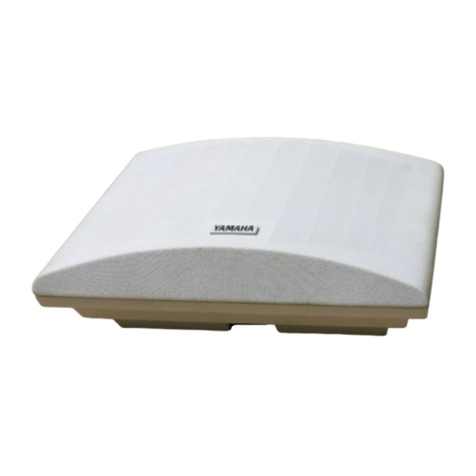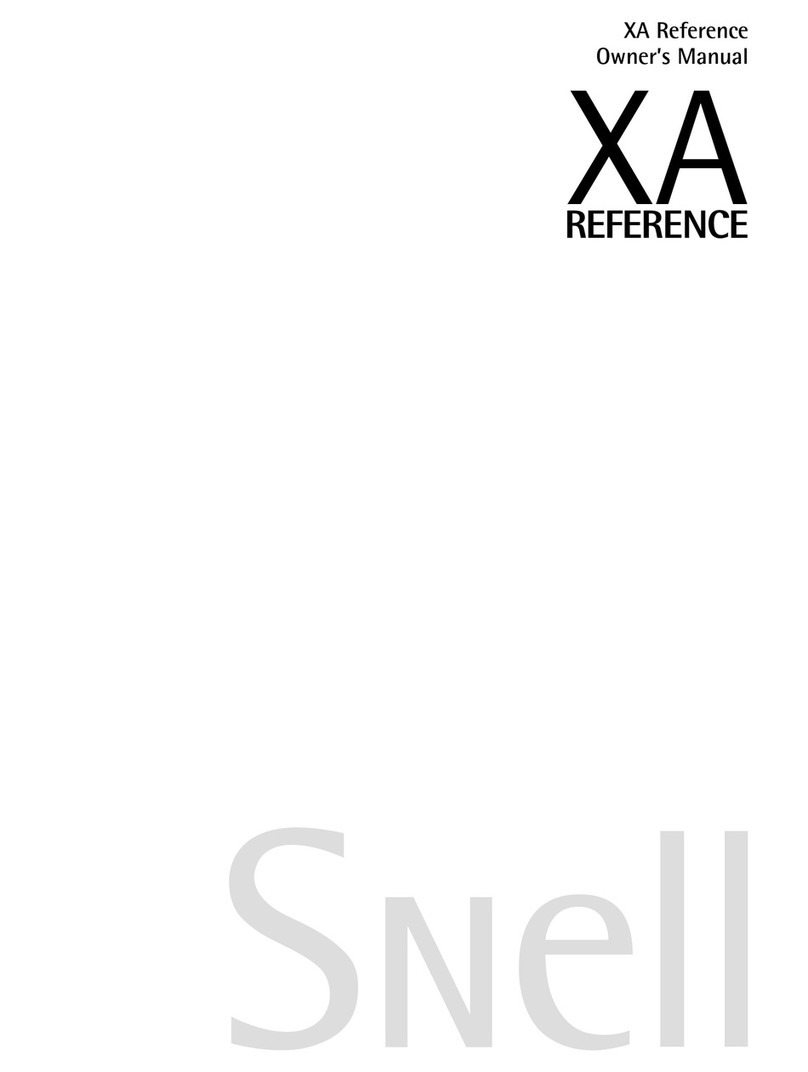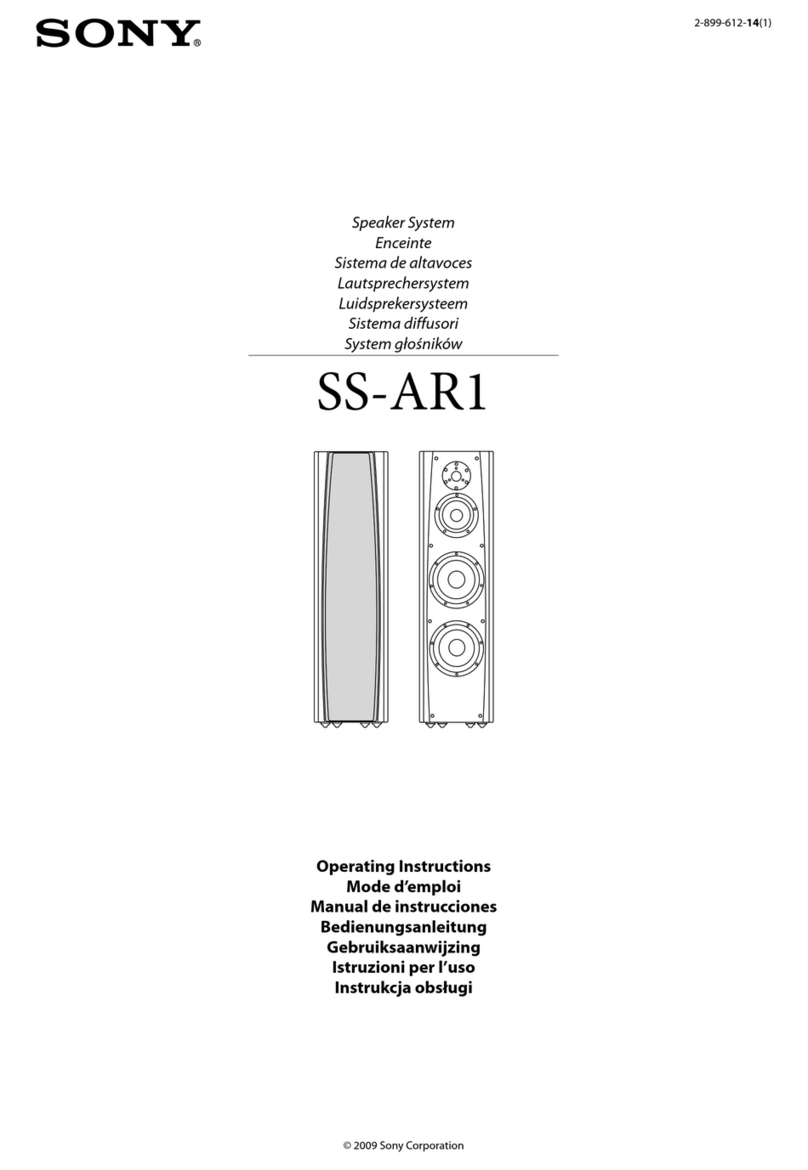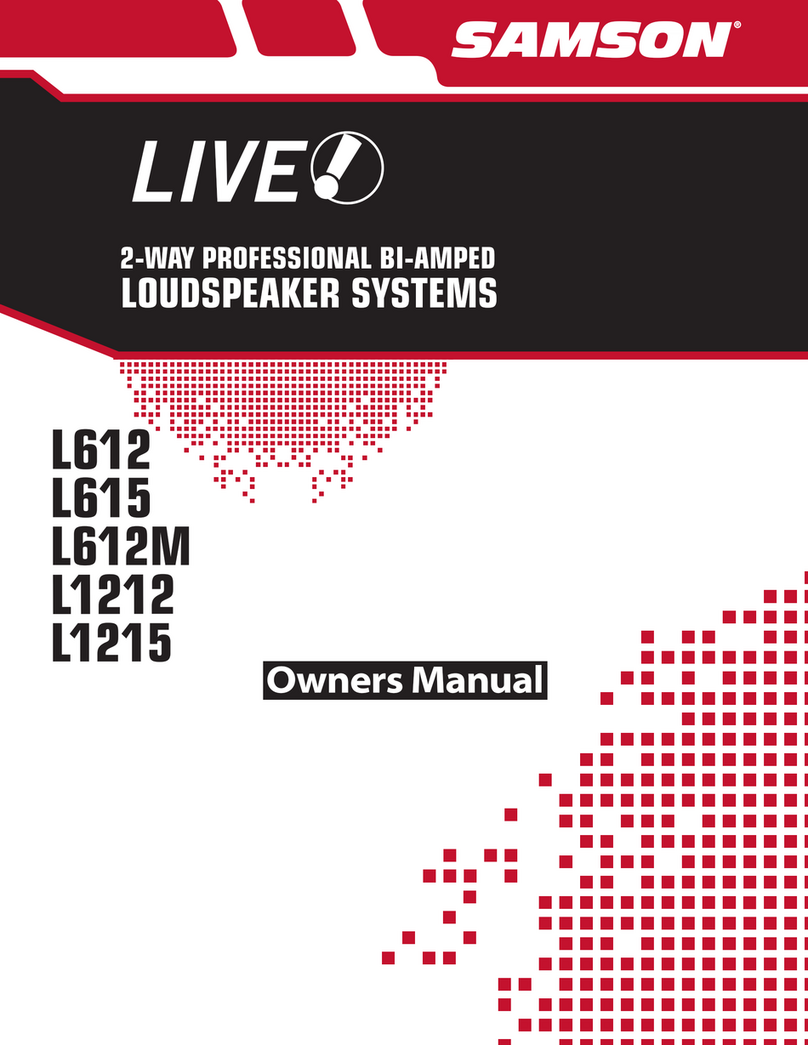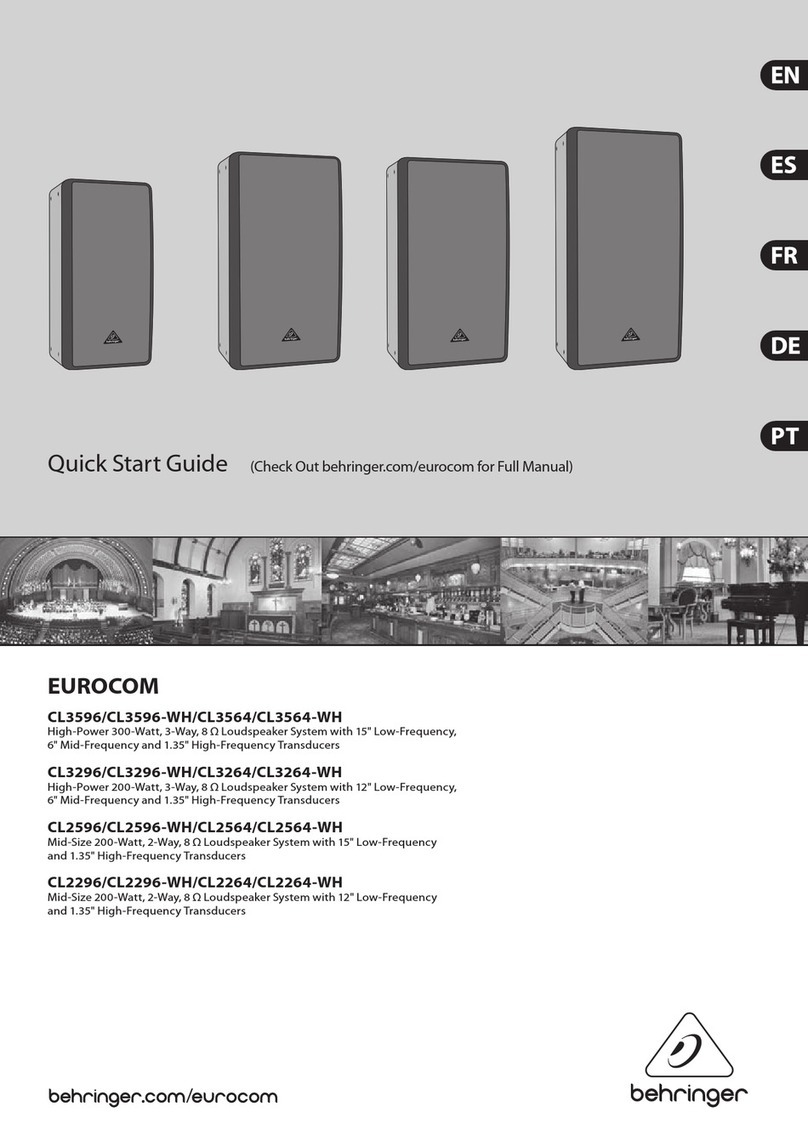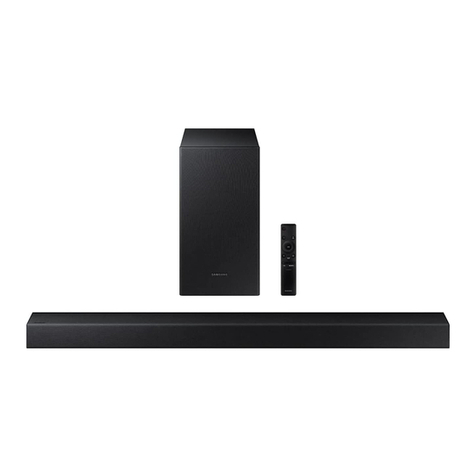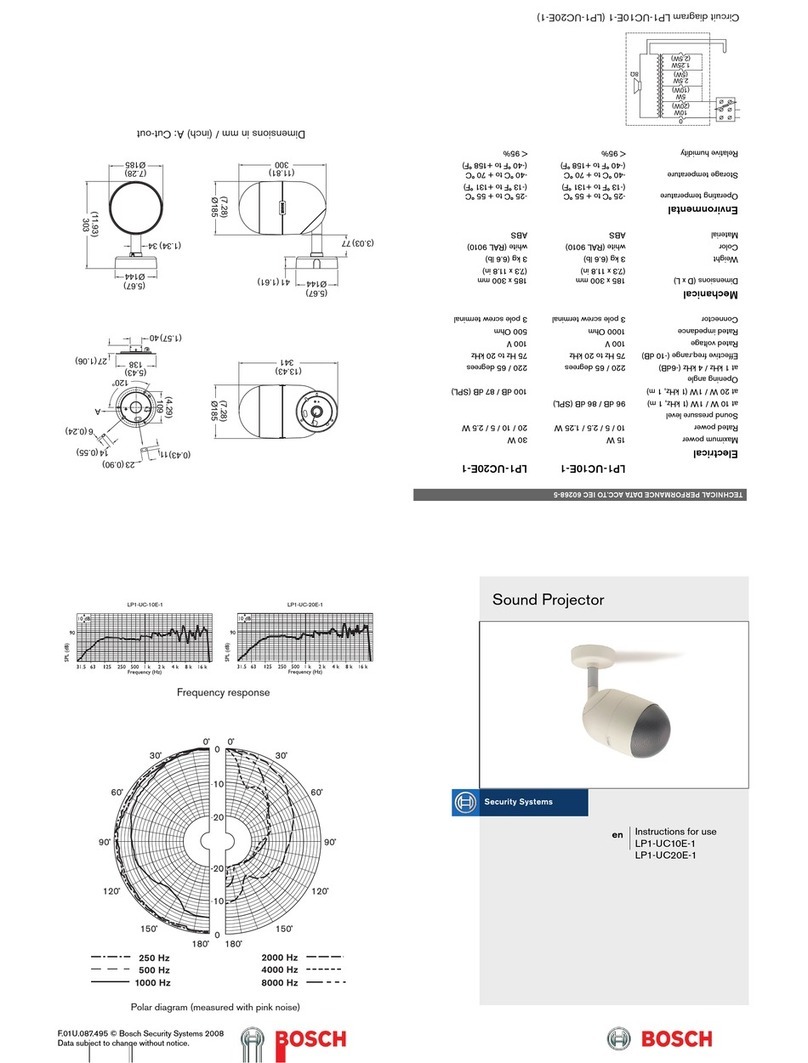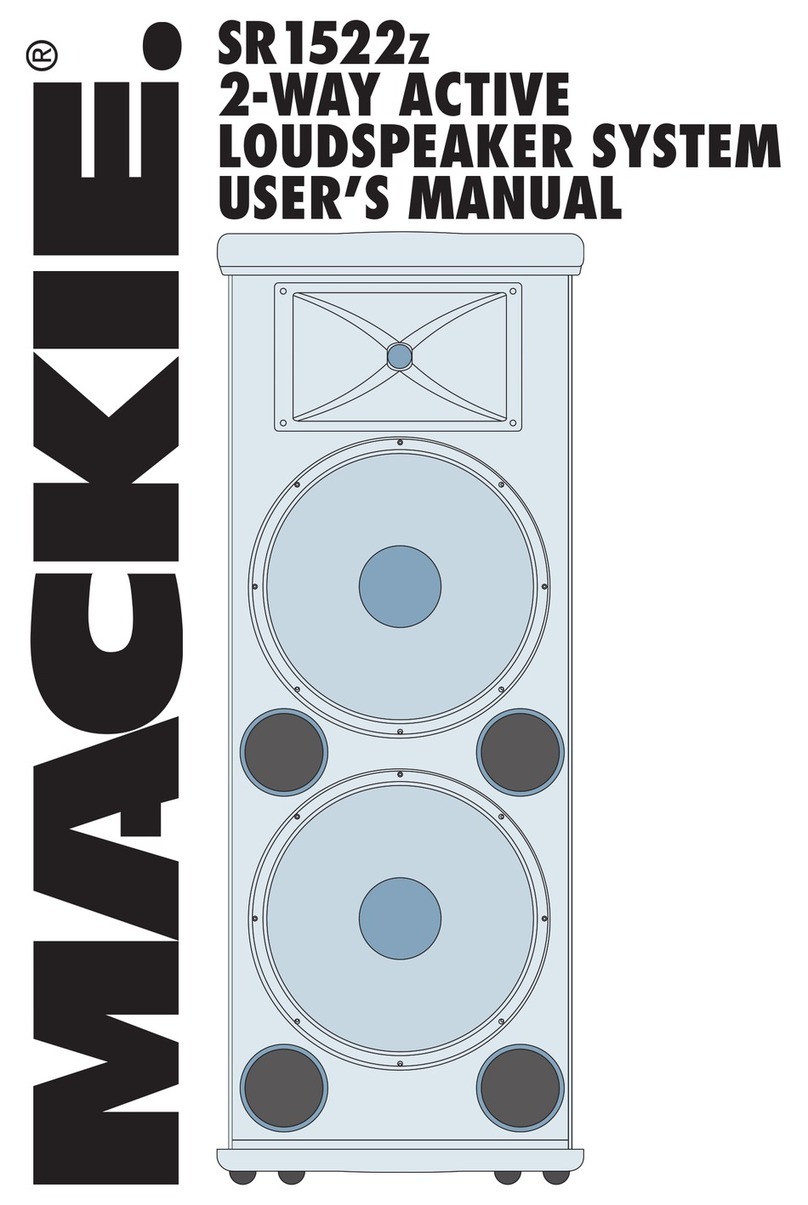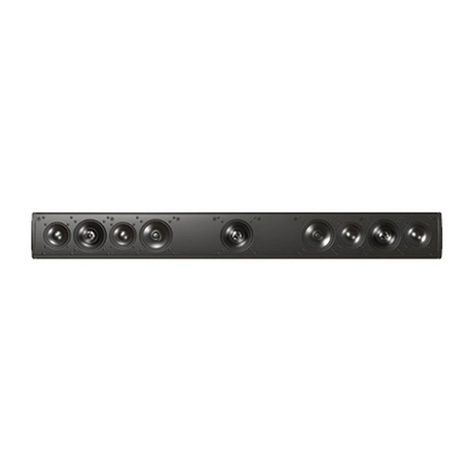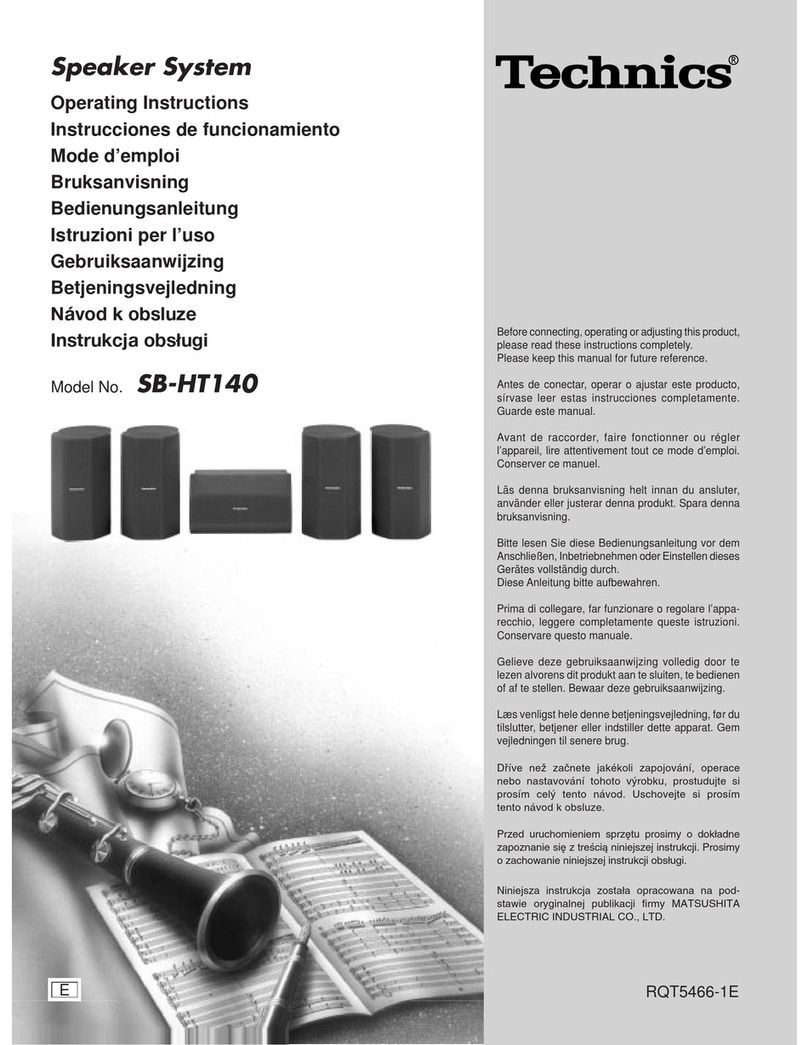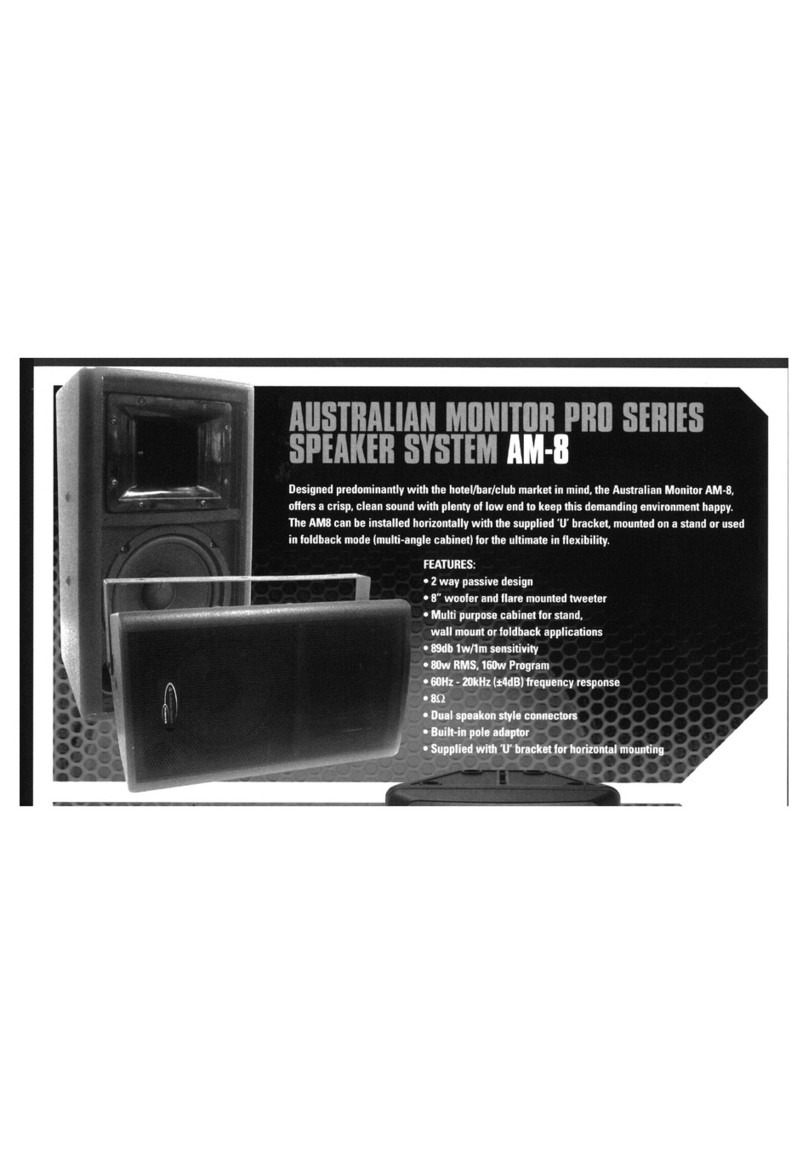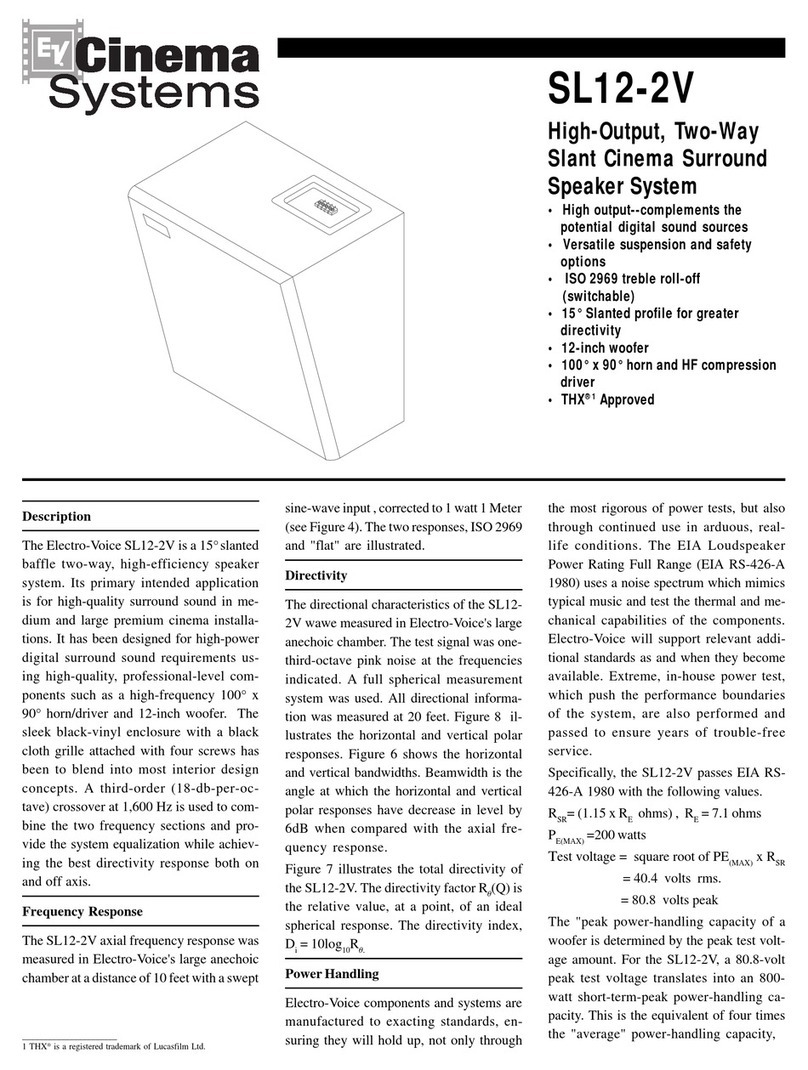Starke sound IC-H7 User manual

IC-H7
Owner’s Manual
STARKE SOUND,INC. California,USA
3939 Atlantic Ave. Ste. 211 Long Beach, CA 90807
T:+1(562) 424-3535
www.starkesound.com

-1-
Specifications IC-H7
*Custom paint and grilles are available for an extra charge
Owner’s Manual
Frequency Response (±2dB)
Recommended Amplifier
Nominal Impedance
Sensitivity (2.83v at 1m)
Tweeter
Midrange
Bass Driver
Crossover Points
Boundary Compensation
Grille
Dimensions
(HxWxD)
Finish
Weight
Shipping Weight
36 Hz-22 kHz
80-450W
4 ohms
92dB SPL
1" STARKE Custom made Golden Ring
Dual 4 inch (118mm)
STARKE Custom made Golden Ring
Dual 8 inch (225mm)
Black anodized Aluminium
Basket
300 Hz / 3kHz
Yes
Gray fabric mesh over MDF frame
34.2 x 13 x 11.8 inches
(870 x 330 x 300mm)
Depth includes 10mm grille
Textured black paint
68.2 lbs (31 kg) / each
80 lbs (36.3 kg) / each

Owner’s Manual
-3-
Location of Front Channel Speakers
Three loudspeakers are to be placed across in the
front of the listening room for the home theater
system. The width of the stereo image is
determined by the distance between the left and
right speakers. The image will be too narrow if the
speakers are placed too close together and,
conversely, if placed too far apart, the blend will
suer creating a void in the middle section.
Your speakers should create a continuous "virtual
image" when properly placed from left to right. As a
result an illusion of sound outside, in front of, and
behind the speaker systems will be created.
Starke Sound recommends a 45 degree to 60
degree angular separation when viewed from
above. The distance between the speakers is 75% of
the distance from the speakers to the listener at the
minimum 45° separation. At the maximum 60°
separation the distance between the speakers is
equal to the distance from the speakers to the
listener.
In order to create a seamless sound image across the front of the speakers one must
carefully consider location and placement.
Optimally, there should an equal distance from the left, right, and center channel
speakers to the listener location.
The height of the midrange/tweeter module of the front channel speakers should be
installed as close as possible to the height of a seated listener's ears. The front channel
tweeters should be located within two vertical feet of that height.
LISTENING
AREA
45° - 60°
-2-
Halo Series
Hi-end performance for custom installations
The concept behind the STARKE Halo series models is simple — loudspeakers that deliver
best performance we can reach with no compromises.These models are housed in
"simple" cabinets and are mechanically and acoustically designed for easy integration into
built-in installations.
In addition, the Halo Series models incorporate design elements that adapt to the
unpredictable acoustical characteristics of custom installations. In some custom
installations, for example, the location of the bass drivers can cause their sound to
interact
with the physical surroundings and produce a mid-bass response error. This results in a
"heavy" or "chesty" quality that is particularly noticeable in vocals. The STARKE Halo IC-H7
and IW-H7 models have Boundary Compensation switches to help control this problem.
Design elements such as this and many others ensure that the Halo Series models
provide
the discerning listener with better experience that provided by a traditional loudspeaker.
IC-H7
Flagship of the Halo series
As the flagship of the Halo series,IC-H7 can be In-Room,In wall or even Behind Screen
installed.We've made every eort to integrate the most advanced technologies into its
design which our team has spent decades refining.IC-H7 use Golden Ring midrange
drivers,tweeters,and special designed woofers for super power bass.we've designed the
IC-H7 to be perfect in each aspects, without compromise.There is many people who
require superior results for home theater and music,It's our hope that the IC-H7 will
satisfy these people.

15°
15°
Owner’s Manual
-4- -5-
Location of Surround Speakers
Starke Sound has provided the following information for the placement of surround
speakers. Although there are many opinions regarding placement and location of
surround speakers Starke Sound has provided the following recommendations based on
thorough research, academics, and our experience with many installations. Note: The
choice of models used in the illustration below is arbitrary. The information described in
the illustrations can be applied to both the IW and the IC series covered in this manual
and in any of the surround locations. However, please keep in mind that the
midrange/tweeter array in the IC-H7 and IW-H7 must always be vertically oriented.
If two surrounds are used in a standard 5.1 configuration (not 7.1 or EX), they are best
mounted directly to the sides of the primary seating location, preferably within ±15° (see
illustration). This placement is the preferred method over back wall mounting for a few
reasons: 1. the placement of the surround speakers are located where the ear's ability to
discriminate left from right is optimum. This produces the maximum sense of
"envelopment" being surrounded by sound, 2. Mounting the rear speakers behind the
listener increases the angle between the front and rear speakers. This results in
reducing the chance that there will be a continuous front-to-rear sound image, lastly, 3.
Since our ability to discriminate the front-to-rear location of a sound source is not very
strong, locating surround speakers to the side of the listener will improve the listening
experience. 7.1 or EX systems that use side and rear speakers together overcome all of
these obstacles and give both maximum envelopment and a more continuous surround
eect.
Another factor that one must consider is the evenness of sound coverage over the
listening area. As most surround processors have the ability to set the balance of all
channels, it is wise to adjust a circulating noise signal in each channel until the apparent
or measured sound level is even. Alternatively, the listener can move to another seat and
the resultant shift will be balance somewhat. Surround speakers placed properly will
minimize the level variation from seat to seat. Increasing the distance of the surround
speakers from the listening area is the best way to improve evenness. Mounting the
speakers high on the side walls or in the ceiling will improve the listening experience.
Surround speakers should be mounted at a minimum of one foot (305 mm) above the
height of a standing listener. Note: In the event of ceiling-mounted speakers, be sure to
place the speakers close to the side walls well away from an overhead position.
If you are planning a large theater room with three or more rows of seating, one needs to
consider that there should be more than one pair of surround speakers in order to give
more even coverage and a more diuse sound field. Starke Sound recommends that a
pair of surround speakers be used for every other seating row (first, third, fifth, etc.). This
method mimics the standard for most cinema applications.
Alternate Surround Speaker Locations
Preferred Surround Speaker Locations

Owner’s Manual
-6- -7-
Speaker Connection
Prior to wiring Starke Sound recommends that you plan
and layout the wiring paths from the speakers to the
amplifier. For runs up to 25 feet Starke Sound
recommends a 16-gauge wire and for runs longer a
14-gauge wire is recommended. Take care to ensure that
the integrity of the speaker wire is not threatened or
compromised by resting/rubbing against any sharp or
pointed objects. Before setting the wire in position be sure
to allow approximately an extra foot (305 mm) of wire at
the speaker location to ensure an easy connection the
speaker.
For standard single wire connections, unscrew one set of
the terminal knobs (rotate counter-clockwise). Remove
approximately 1/2" (12mm) of the wire insulation from the
two wire conductors and twist the wire strands into a tight
bundle. Insert the wire
into the terminal shaft hole and rotate the terminal knob
clockwise to secure the wire in place. Take care that there
are no stray or loose strands of wire that could touch the
other terminal shaft.
Confirm that both the positive and negative speaker terminals of the
amplifier are in connection with the corresponding + (red) and - (black) terminals at the
speakers. If you look closely you will see that all wire is marked in some way to trace their
respective connections. The two conductors will striped or ridged insulation in order to
identify them. Alternatively the conductors may be color coded to ensure their identity.
Wires with pin lugs or spade lugs are also accepted by the terminals. In addition, dual
banana plugs can be plugged into the rear of the terminals.
Series/parallel wiring should be used when connecting more than two speakers per
amplifier channel. Make certain in all cases that the total impedance does not fall below
the amplifier's rating. If there is any question be sure to contact your Starke Sound
dealer.
Bi-Wiring
Bi-wiring the speakers can oer benefits for high
performance audio systems. This methodinvolves
connecting two sets of wires betweenthe amplifier
and the speakers. You must firstremove the terminal
straps by loosing theterminal knobs and sliding the
straps to the side.
Keep the midrange and tweeter teminals conecting.
Only remove the jump wires between Midrange and
woofer teminals.
Be sure to use equal lengths of the appropriate
wire for bi-wiring the speakers. Consult your Starke
Sound dealer for dierent cable options.
See illustration for amplifier to speakers connections.
Bi-Amplification
Bi-amplified speakers can achieve a higher
level of performance for the listener. This type of
system employs two separate
amplifiers to drive the speakers. The first
amplifier
drives the midrange/tweeter array, while the
second drives the
bass speakers. Similarly with bi-wiring, one must
remove the jumper wires between midrange and
woofer teminals. Once this has been done you
simply
connect the speakers as described in the
illustration.
Note: In any case NEVER apply an external
crossover of any sort,
whether its passive or active. This will result in
unwanted interference with the phase and
frequency response of the speakers. The internal
crossover circuitry is an integral part of the
speakers and necessary to the proper response
and function of its
array and overall performance.
Note: The amplifiers used to bi-amplify
the speakers must be identical.

Owner’s Manual
-8- -9-
Tri-Wiring
Similarly with bi-wiring,but this time you should remove all
connections between the speakers terminals.
This method involves connecting three sets of wires between
the amplifier and the speakers.
Be sure to use equal lengths of the appropriate wire for
Tri-wiring the speakers. Consult your Starke Sound dealer
for dierent cable options.
See illustration for amplifier to speakers connections.
Be sure to use equal lengths of the appropriate wire for
bi-wiring the speakers. Consult your Starke Sound dealer for
dierent cable options.
See illustration for amplifier to speakers connections.
Tri-Amplification
Tri-amplified speakers can achieve the highest
level of performance for the listener. This type of
system employs three separate
amplifiers to drive the speakers. The first
amplifier
drives the tweeter, the second drives the
midrange array,
the third one drives the bass speakers. Similarly
with tri-wiring, one must
remove the jumper wires from the connection
teminals. Once this has been done you simply
connect the speakers as described in the
illustration.
Note: In any case NEVER apply an external
crossover of any sort,
whether its passive or active. This will result in
unwanted interference with the phase and
frequency response of the speakers. The internal
crossover circuitry is an integral part of the
speakers and necessary to the proper response
and function of its
array and overall performance.
Note: The amplifiers used to Tri-amplify
the speakers must be identical.
Boundary and Tweeter Control Settings
The connection terminal cup has two switches that enable you to fine tune adjustments
to the response of the speakers. These can be utilized to achieve the best possible
performance from your speakers in a variety of installation situations.
Boundary Switch If you find it necessary to install the speakers in a situation where they
may not produce the best overall sound balance then one can adjust the Boundary
switch to improve the overall performance of the speakers. For instance, in order get the
best sound image, the speakers
must be installed close to a corner or a large object that forms a corner. Examples could
include a fireplace or a large column. This can result in an uneven response in the upper
bass and lower midrange which produces a “thick” or “heavy” sound. In vocal
reproduction this is particularly noticeable. To control this there is a Boundary Switch
located above the connection terminals.
When speakers are located less than 12"-18" (300-450mm) from a corner or other large
object, adjust the Boundary Position switch setting. Starke Sound recommends using
strong vocal source material to see if this setting produces smoother, more natural
sound.
Tweeter Level Switch
The IC-H7 and IW-H7 series speakers have a three-position switch to adjust the output
level of the tweeter. In most situations, the middle "0dB" position will produce the best
sound. In rooms that have high acoustical absorbing properties such as plush carpeting
and heavily upholstered furniture try the switch in the "+2dB" position. In rooms that
have highly reflective surfaces such as stone or hard wood paneling, try the "-2dB"
position.
+2dB
0 dB
-2 dB
Normal
Boundary

Owner’s Manual
-10- -11-
Power Handling and Listening Levels
Starke Sound recommends reasonable power output settings for the amplifier so it
operates in a way that will not result in distortion. Even a modest amplifier, if producing
distortion, can damage speakers. Turn down the volume if you hear a gritty noise or
other signs of strain. Prolonged or repeated operation of your speakers with a distorted
signal can cause damage that is not covered by the warranty. Note that it is imperative
you do not overdrive the bass capability of smaller speakers. Listen for noises, such as
pops, caused by the music's bass line. Use of the loudness control and/or full bass boost
at louder volumes is likely to overdrive the woofer. Use such controls sparingly.
How to Care for your Speakers
Slightly dampen a soft terry cloth towel with water, glass cleaner, or a diluted mild
detergent and then carefully clean the speakers. The towel should be just damp enough
to wipe the surface clean without leaving a trail of moisture. Do not, under any
circumstances, use abrasive cleaners or any cleaner containing chemicals harsher than
those found in glass cleaner.
Limited warranty
STARKE SOUND will repair for the original owner any defect in materials or
workmanship that occurs in normal use of the speaker system, without charge for
parts and labor for ten years from the date of purchase.
It is your responsibility to use the product according to the instructions supplied, to
provide safe and secure transportation to an authorized Starke Sound service
representative, and to present proof of purchase from an authorized Starke Sound
dealer in the form of your sales slip when requesting service.
Damage that results from abuse, misuse, accidents, shipping,
repairs, or modifications by anyone other than an authorized Starke Sound service
representative is excluded from this warranty. This warranty is void if the serial
number has been removed or defaced.
This warranty gives you specific legal rights, and you may also have other rights that
vary from state to state.
If Service Seems Necessary
Contact the dealer from whom you purchased the speaker system. If that is not
possible, call us at
+1(562) 424-3535
E-mail:[email protected]
or write to: STARKE SOUND,INC. California,USA
3939 Atlantic Ave. Ste. 211 Long Beach, CA 90807
We will promptly advise you of what action to take. If it is necessary to return your
speaker system to the factory, please ship it prepaid in the original factory packaging.
Please note that Starke Sound will not be held liable for shipping damage due to
improper packaging. After it has been repaired, we will return it freight prepaid in the
U.S. or Canada.
for Europe Customers only
This symbol found on the product indicates that the product must
not be disposed of with household waste. Instead, it may be placed
in a separate collection facility for electronic waste or returned to a
retailer when purchasing similar product. The producer paid to
recycle this product. Doing this contributes to reuse and recycling,
minimizes adverse eects on the environment and human health
and avoids any fines for incorrect disposal.
Table of contents
Other Starke sound Speakers System manuals


